Please Take Note: This is a review of the final game, but it might change slightly based on the success of the Kickstarter campaign. The game is being reviewed on the components and the rules provided with the understanding that “what you see is not what you might get” when the game is published. If you like what you read and want to learn more, we encourage you to visit the game publisher’s website or visit the Kickstarter campaign. Now that we have all that disclaimer junk out of the way, on with the review.
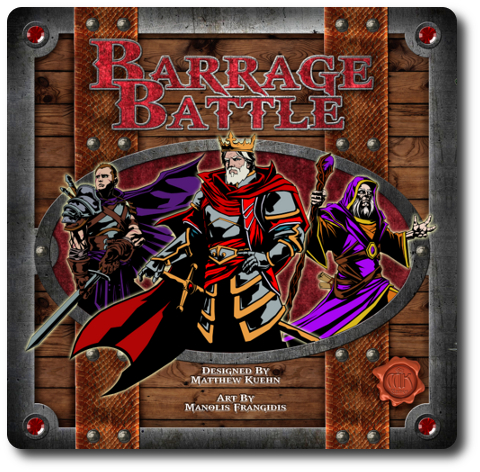
The Basics:
- For ages 8 and up (publisher suggests 10+)
- For 2 players
- Approximately 60 minutes to complete
Geek Skills:
- Active Listening & Communication
- Counting & Math
- Logical & Critical Decision Making
- Reading
- Strategy & Tactics
- Risk vs. Reward
- Visuospatial Skills
- Hand/Resource Management
Learning Curve:
- Child – Easy
- Adult – Easy
Theme & Narrative:
- Defeat you enemies, one card play at a time
Endorsements:
- Gamer Geek mixed!
- Parent Geek approved!
- Child Geek approved!
Overview
The 18th President of the United States, Ulysses S. Grant, said “The art of war is simple enough. Find out where your enemy is. Get at him as soon as you can. Strike him as hard as you can, and keep moving.” In this game, the trick to victory is pressing the advantage, but striking it with a balance. Warmongers will have might on their side, while those who seek other routes will find different roads to victory.
Barrage Battle, designed by Matt Kuehn, Raechel Mykytiuk, and to be published by MK Games, will reportedly be comprised of 1 large game board, 128 cards, 4 standard four-sided dice, 4 standard six-sided dice, 4 Crystal Caste six-sided dice (unique crystal-like dice with six sides, think Dark Crystal shards with numbers), 2 standard ten-sided dice, 2 standard twelve-sided dice, 20 Gold Coin tokens, 20 Mana Crystal tokens, 20 Damage counters, and 6 Hit Point counters. As this is a review of a prepublished game, I cannot comment on the game component quality. The illustrations of the various characters and war machines in the game were expertly done by Manolis Frangidis. Each card has a distinct feel, making it easy for the player to imagine the chaos on the battlefield.
Preparing for War
To set up the game, first set the game board in the middle of the playing area. The players should sit opposite of each other with the noticeable middle “No Man’s Land” between them.
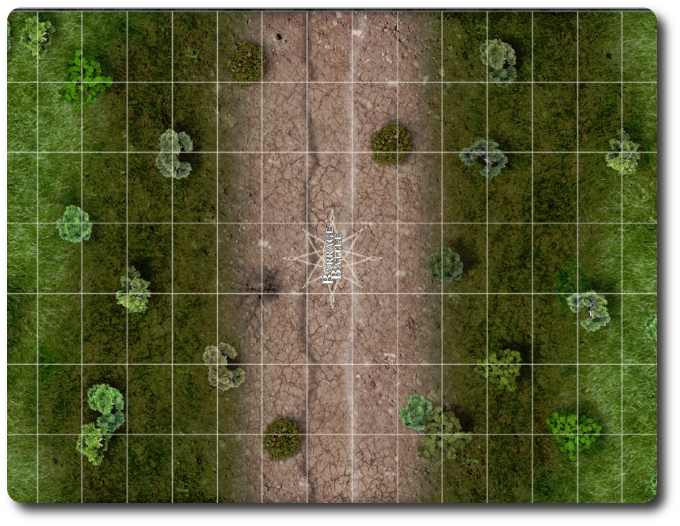
Second, find and give to each player 1 “King” Unit card, 1 “Wizard” Unit card, and 1 “Castle” Structure card. The “Castle” Structure card must be placed within the first two rows closest to the player. The “Wizard” and the “King” may be placed anywhere on the player’s side, as long as it’s within the player’s territory. A player’s territory is considered the rows closest to the player and ending in the middle where the “No Man’s Land” begins (the row that separates the players’ territories)
Third, shuffle the remaining cards and deal 10 to each player, face-down. This is the player’s starting hand of cards. Players should look at them, but keep them hidden until played. Place the remaining deck of cards face-down to one side of the game board. This is the draw deck for the duration of the game. Leave room for a discard pile.
Fourth, separate the dice and tokens by type to one side of the game board and within easy reach of all the players.
That’s it for game set up. Determine who will go first and begin.
A Tour of the Kingdom
Barrage Battle primarily uses cards which represent different characters, units, locations, and magical events in the game. Each of the cards are summarized here.
The Unit Cards
The Unit cards represent all of the fighting forces in the game, including the starting “King” and the “Wizard”. Units also include the “Dames” (warrior women with a penchant for butt-kicking at close and long range), “Swordsmen” (skilled and deadly warriors), “Knights” (armored combatants who charge into danger), “Archers” (fighters who strike from a distance), and “Javelineers” (a more deadly version of the Archer).
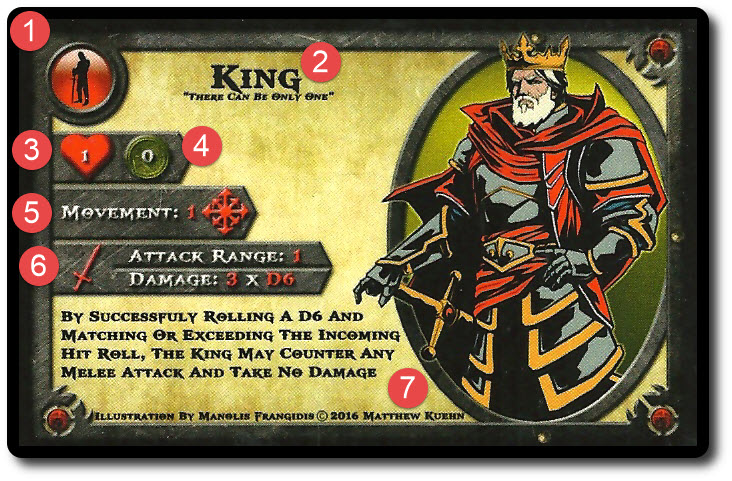
- Icon identifying the card as a Unit.
- The name of the Unit card.
- The Hit Points of the Unit cards
- The cost (in Gold Coins) to bring the Unit card into play
- The number of spaces and movement direction the Unit card can take
- The attack type (in this case, Melee) and the number of dice rolled to determine damage
- Additional information about the Unit card
The Structure Cards
The Structure cards consist of “Castles” and “Walls”. They act as points of deployment and defensive barriers.
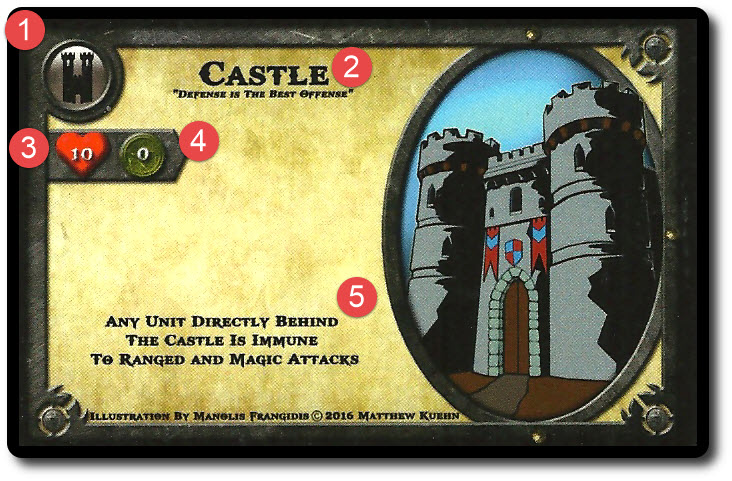
- Icon identifying the card as a Structure.
- The name of the Structure card.
- The Hit Points of the Structure cards
- The cost (in Gold Coins) to bring the Structure card into play
- Additional information about the Structure card
The War Machine Cards
The War Machine cards represent the large man-made structures designed for war. Their deployment and mobility is limited and they tend to stay close to the player’s structures, adding support for friendly troops and devastation to the enemy. “Siege Towers”, “Ballistas”, and “Catapults” function like units on steroids and can even protect units on the battlefield like a structure.
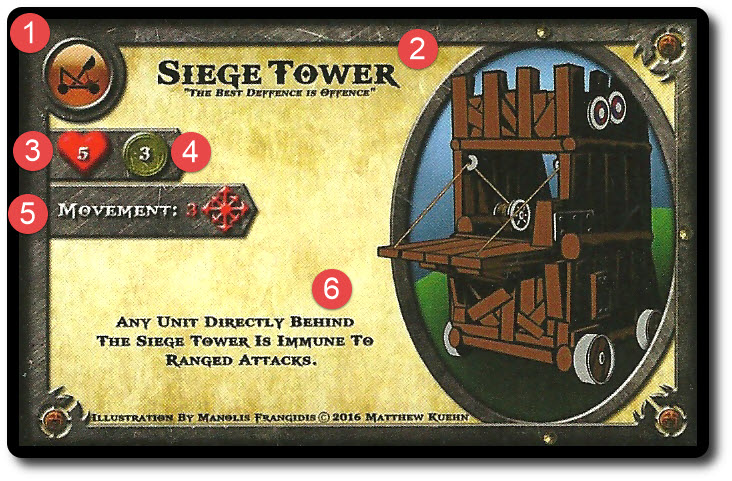
- Icon identifying the card as a War Machine.
- The name of the War Machine card
- The Hit Points of the War Machine cards
- The cost (in Gold Coins) to bring the War Machine card into play
- The number of spaces and movement direction the War Machine card can take
- Additional information about the War Machine card
The Spell Cards
In a time where might makes right and the strong rule, the difference between and strong blade and a magical spell is oftentimes moot. The “Wizard” Unit card has the ability to cast spells by using Mana Crystals that power their arcane arts. Such power comes at a cost and the Mana Crystals are not easy to come by. The “Wizard” Unit card is powerful, but its usefulness is directly tied to how much time and attention a player wants to spend on magic versus might.

- Icon identifying the card as a Spell.
- The name of the Spell card.
- The cost (in Mana) to bring the Spell card into play
- Additional information about the Spell card
The Rules of War
Barrage Battle is played in turns and phases. A typical player’s game turn is summarized here.
Phase 1: Declaration of Intent
The first thing a player must do on their turn is declare their intent. Declaring an intent determines how effective a player will be during their turn. The declarations are as follows:
- Declaration of War: Player takes 0 Gold Coin tokens, may take 3 Movement, and has 5 Actions.
- Declaration of Peace: Player takes 5 Gold Coin tokens, may take 3 Movement, and has 0 Actions. Any Unit and War Machine cards cannot be moved into their opponent’s territory.
- Declaration of Diplomacy: Player takes 3 Gold Coins, may take 3 Movement, and has 3 Actions.
As you can see, the player’s declaration directly provides funds, tactical movement, and strategic actions, but the number is fully based on what the player plans to do. Aggressive players will lose out on funds, but will have a lot of opportunity to control forces. Those seeking a brief respite from the battle can collect funds, but will not be able to take actions. Finally, those seeking a more civilized solution, will be able to take advantage of acquiring fortune and taking actions, but at a reduced level of effectiveness.
Phase 2: Upkeep
Based on the declaration taken, the player will collect their Gold Coins and 1 Mana Crystal if their “Wizard” Unit card is in play. These are placed with any other Gold Coins and Mana Crystals the player may have. Any unspent resources are saved and can be used later in the game.
At this time, any Unit and Spell cards can also take effect and are resolved if applicable.
Phase 3: Deployment
The player can now put into play any Unit, War Machine, or Structure cards they have in their hand if they can pay for it by discarding their Gold Coin tokens. When put into play, Unit cards must be placed in an empty adjacent space and touching a Structure card (not diagonal). War Machine and Structure cards must be placed within 2 rows of a Structure card already in play.
Phase 4: Movement
Regardless of the player’s declaration during their turn, they will have 3 Movement. Each card can only be moved once per turn and the number of spaces it can move and in what direction are listed on the card. Players should pay close attention to the movement of the cards to ensure they don’t move them into a position they cannot attack from.
Phase 5: Take Actions
Depending on the declaration taken by the player, they will either have 0, 3, or 5 Actions. If the player doesn’t have any actions, they skip this phase.
There are a number of different actions to select from. Some will only cost 1 Action and some will cost more. The player can take as many actions as they like as long as they do not take more than they have available. Unlike Gold Coins and Mana Crystals, players cannot save their unused Actions for later.
- Spend 2 Actions to discard any number of cards in the player’s hand and then draw that many cards to replace them
- Spend 1 Action to use a “Spell” card
- Spend 1 Action to attack
Using Spells
For 1 Action and spending the required number of Mana Crystals, the player can reveal a “Spell” card and resolve its effects. “Spell” cards can only be played if the player has the “Wizard” card in play, as well. Once the Mana Crystals have been discarded, the spell is cast and the results are based on the “Spell” card description. Most of the time, the player will only need to point to a card and announce what happens. Other times, the player will have to resolve the card’s effects by completing an attack.
Attacking
Attacks come int two different types. These are Melee (close ranged) and Ranged (long ranged). A Melee attack is only possible if cards from two opposing sides are adjacent to each other. The player who is attacking rolls a number of six-sided dice based on their card and counts the number of die rolls that resulted in a “4”, “5” or “6”. Each result with these number is considered a hit and inflicts 1 point of Damage.
Ranged combat is a bit different and requires the player to roll a number of dice (as indicated on their card) from any place behind the attacking card’s current position on the game board. The player then tosses the dice towards the target card. Any dice that land on the target card counts as 1 point of damage. Caution should be taken because any dice thrown that land on a friendly unit will do damage! Ranged attacks can never target a card behind the attacking card’s position and the target card can never be adjacent to the attacking card. Cards behind structures are protected from ranged attacks, be they arrow, javelin, or spell.
Death
In all cases, damage inflicted by spells or by attacks will damage a card’s Hit Points. When the card’s Hit Points are reduced to zero or less, they are removed from the game board and placed in the discard pile.
Phase 6: End of Turn
The player’s turn is now over. They draw back up to 10 cards or discard down to 10 cards, depending on how many cards they currently have in their hand.
The War Comes to an End
The game continues as described above, until 1 player loses their “King” Unit card. They have lost the game and their opponent has won the day and the kingdom.
To learn more about Barrage Battle, visit the game publisher’s website or visit the Kickstarter campaign.
Final Word
The Child Geeks had no problem learning how to play this game. Each card clearly tells the player what it can and cannot do. Movement on the game board is easy to grasp, as well, with the only obstacles being other cards. Without any terrain to speak of, the Child Geeks had the ability to explore the entire game board if they wanted to, but they seldom did. All the Child Geeks quickly learned that the best approach to winning the game was to attack fast and attack often. According to one Child Geek, “This is the kind of game that favors the player who is attacking. I don’t know why you wouldn’t attack all the time.” Some of the Child Geeks thought they would try to win through Spells or by building a big army, but the winning strategy always seemed to be as aggressive as possible. As one Child Geek put it, “The game isn’t hard, but it is brutal. This shouldn’t be played by one who doesn’t like games where they get attacked.” All the Child Geeks, who I guess did like being attacked (or attacking), voted to approve Barrage Battle.
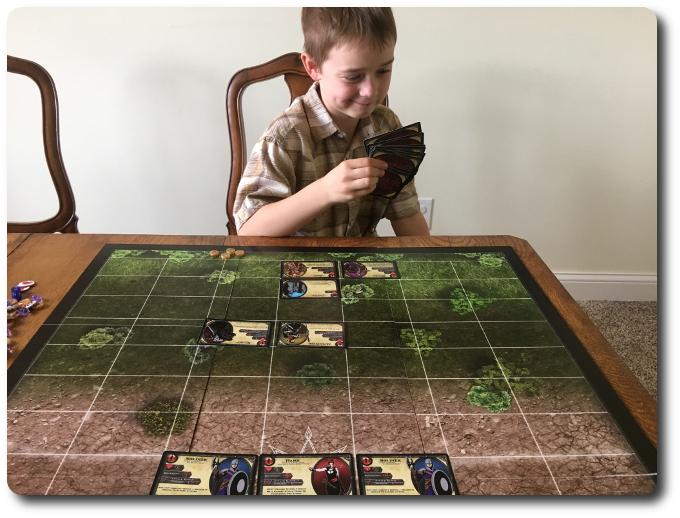
A smirk from my opponent could mean anything – in this case, DEATH BY MAGIC!!!!
The Parent Geeks had a more measured approach to the game when they played with their peers, preferring to take their time and work around an opponent’s defenses. According to one Parent Geek, “The game gives the players a lot to think about in a very easy way. I don’t feel overwhelmed and I also know I can always do something.” That something, however almost always resulted in an attack. The only time the Parent Geeks didn’t attack each other was when they were obtaining gold to pay for soldiers who would attack later. As one Parent Geek put it, “Without gold you are screwed.” With their children, the Parent Geeks learned that the Child Geeks have a surprisingly vicious side, which the Parent Geeks met with an equal level of viciousness. By the time the battleground was littered with the remains of the fallen, the Parent Geeks gave Barrage Battle their full approval.
The Gamer Geeks rolled their eyes at this game. “Oh, look. Another Summoner Wars clone. How original.” Sarcasm aside, the Gamer Geeks did recognize a lot of the game’s mechanics and found little in the game to be original. They did like that the dice were thrown to represent ranged combat, but didn’t like that the dice value rolled didn’t represent the damage inflicted. According to one Gamer Geek, “This game has a lot of other people’s’ good ideas in it, and I guess there is nothing really wrong with the game as a whole. It’s just that I’ve seem it all before and it really didn’t interest me.” In short, the Gamer Geeks, who play a lot of games, didn’t find the game to be a bad one, but nor did they feel drawn to it. When asked to vote on it, the Gamer Geeks were split. A number of them voted to approve the game, simply because they thought the game was well designed and did exactly what it said it would do. The other half decided to vote it down since they found the game to be a mix of ideas and game play that were already in other games, reducing its overall appeal due to its lack or originality.
Barrage Battle does have similar game play to other games, but what of it? I’ll leave it up to you, the reader, to determine if a game must be unique to be “good”. As for me, I judge a game on the game play. How did it make me feel? Was I challenged? Was I entertained? Did I ever feel excited or frustrated? Barrage Battle is not a particularly difficult game to learn and can be an absolute cake walk to win if you aren’t playing against an opponent who is being aggressive. The real charm of Barrage Battle is that it keeps you in the game until the very end, but also gives you enough rope to hang yourself. Declarations of intent for the player’s turn are really, really important. If you run out of funds, you are going to be hurting and will need to spend time getting some gold to support your army. Doing so will give your opponent an advantage and control of the battlefield if they choose Diplomacy or War.
In truth, the only aspect of the game the felt like an important decision was the declaration. Everything else was pretty obvious. Moving cards and such is always towards the opponent’s King or moving the card into a better position to help other cards get the King. The only restriction are the resources and you can get cards pretty easily. It’s Gold and Mana that are hard to come by. Unfortunately, players cannot win either while attacking. They must collect them instead of obtaining them as spoils of war.
Magic is interesting, but ultimately either useless or terribly devastating, with no real gray area in between. If played right and at the right time, an “Earthquake” Spell card will win the game. The same spell, used early in the game, is nothing more than a nuisance. Timing is more important with Spells than what it targets. This was a neat touch in a game that was primarily about aggressive plays.
The tactical and strategic game play is abundant, but also pretty obvious. There are always meaningful choices to be made, but seldom are there significant negative results to hinder a player’s ability to take action. Which is a very good thing. Nothing hurts game play more than long bouts of players over thinking their move. Limited movement and resources always keep the battlefield tidy and the choices are sometimes limited, but not restrictive.
Overall, I’m pleased with the game. I have played enough games similar to Barrage Battle to reduce its overall level excitement, but like half of the Gamer Geeks, I do not find that to be a fault. Playing it with my children is fun and drawing just the right card at the right time feels like you’ve won a mini battle in the war. If you are looking for a fast game, where there are always choices to be made, limited resources to be had, and a clear goal to attain, do play Barrage Battle.
This is a paid for review of the game’s final prototype. Although our time and focus was financially compensated, our words are our own. We’d need at least 10 million dollars before we started saying what other people wanted. Such is the statuesque and legendary integrity of Father Geek which cannot be bought except by those who own their own private islands and small countries.



